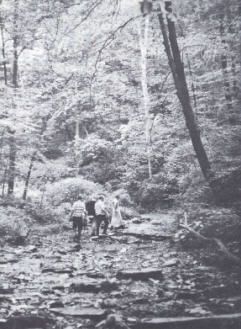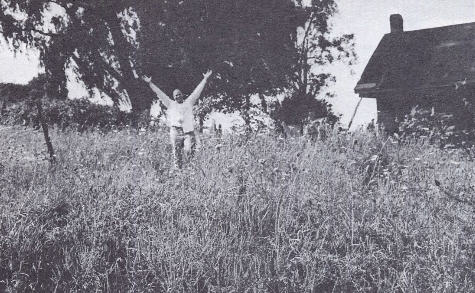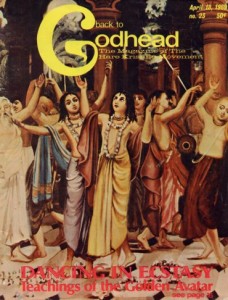by Hayagriva Dasa
A spritual concept of community life
One practical aspect of the Krishna Consciousness Movement is now taking form in the hills of West Virginia. This is a report on the development and the philosophical background of that important project.
“You have New York, New England and so many ‘new’ duplicates of European places in the USA why not import New Vrindaban in your country?” -A.C. Bhaktivedanta Swami, in a letter to his disciples
New Vrindaban, a spiritual community united in the pursuit of Krishna Consciousness, is now taking shape under the guidance of our Guru Maharaj, A. C . Bhaktivedanta Swami. Now the hills of West Virginia are vibrating daily with the Maha (Hare Krishna) Mantra, and it is certain that the forests, fields and mountains are no longer in West Virginia they have entered the spiritual sky of Vaikuntha. By the mere touch of sound, everything at New Vrindaban is Krishna-ized. And by the mercy of the spiritual master, America is seeing a resurgence of God consciousness.
The conception and purpose of New Vrindaban are best set forth in the letters of Swamiji himself. Primarily, the place is intended to serve as an amiable location for reviving our dormant God consciousness. In New Vrindaban, remembrance of Krishna is easy because the atmosphere is conducive: “We can remember Krishna in every moment. We remember Krishna while taking a glass of water, because the taste of water is Krishna. We can remember Krishna as soon as we see the sunlight in the morning, because the sunlight is a reflection of Krishna’s bodily effulgence. And as soon as we see moonlight in the evening, we remember Krishna, because moonlight is the reflection of sunlight. Similarly, when we hear any sound, we can remember Krishna because sound is Krishna, and the most perfect sound, transcendental, is Hare Krishna, which we have to chant 24 hours. So there is no scope of forgetting Krishna at any moment of our life, provided we practice in this way.”
The atmosphere of New Vrindaban is suitable for such a remembrance process it is cosmic, rural, woodsy. Under the Milky Way, Kirtan the chanting of Hare Krishna to the accompaniment of musical instruments expands. Orion, Saggitarius, Virgo all vibrate to the cymbal rhythm, the sounds loosed in the night, broadcast from the mountains of planet earth. The firmament revolves around Vrindaban the Maha Mantra twirls it about.
Life revolves about the Maha Mantra the charting of the Holy Names. There is Kirtan, group chanting, every morning and evening. Aritik cymbal clashing, offering to the Deity is performed before dawn and four times throughout the day. The morning Kirtan is usually over before sunrise. Then morning “Prasadam,” food first offered for the pleasure of the Lord, is taken, usually cereal, and the day’s chores begin. There is much work at New Vrindaban, and all participate.
The system and purpose of New Vrindaban is set forth specifically in the letters of Swamiji:
“Vrindaban conception is that of a transcendental village, without any of the botheration of the modern industrial atmosphere. My idea of developing New Vrindaban is to create an atmosphere of spiritual life where people in the bona fide divisions of society namely, Brahmacharies [celibate students], Grihasthas [householders], Vanaprasthas [the retired], and Sannyasis [renounced holy men] will live independently, completely depending on agricultural produce and milk from the cows.” (8/17/68)
“To retire from activities is not a very good idea for the conditioned soul. I have very good experience, not only in our country, but also in your country, that this tendency of retiring from activities pushes one down to the platform of laziness, and gradually to the ideas of the hippies.
“One should always remain active in Krishna’s service, otherwise strong Maya [illusion] will catch him and engage him in her service. Our constitutional position being to render service, we cannot stop activity. So NewVrindaban may not be turned into a place of retirement, but some sort of activities must go on there. If there is good prospective land, we should produce some grains, flowers and fruits, and keep cows, so that those living there may have sufficient work and facility for advancing in Krishna Consciousness. In India, actually, Vrindaban has now become a place of the unemployed and of beggars. Kirtanananda has already seen it. And so there is always a tendency toward such degradation if there is no sufficient work in the service of Krishna. ” (7/14/68)
From the beginning, as Swamiji suggested, the program at New Vrindaban has been geared to enable the student to progress along the path of devotional service, and so there is work going on all the time. And the program is sufficiently diversified to accommodate a variety of talents, dovetailing them in Krishna’s service.
As in the many transcendentalist farms of 19th century America, the concept of life at New Vrindaban is that of plain living and high thinking.
“Vrindaban does not require to be modernized, because Krishna’s Vrindaban is a transcendental village. They completely depend on nature’s beauty and nature’s protection. The community in which Krishna preferred to belong was the Vaishya community, because Nanda Maharaj [Krishna's foster father, with whom He spent His childhood while on Earth] happened to be a Vaishya king, or landholder, and his main business was cow protection. It is understood that he had 900,000 cows, and Krishna and Balaram used to take charge of them, along with Krishna’s many cowherd boy friends. Every day, in the morning, He used to go out with His friends and cows into the pasturing grounds.
“So, if you seriously want to convert this spot into New Vrindaban, I shall advise you not to make it very much modernized. But as you are American boys, you must make it just suitable to your minimum needs. Nor should you make it too much luxurious, as generally Europeans and Americans are accustomed. Better to live there without modern amenities, and to live a natural, healthy life for executing Krishna Consciousness. It may be an ideal village where the residents will have plain living and high thinking.

Walking path to the original New Vrindaban farm.
“For plain living we must have sufficient land for raising crops, and pasturing grounds for the cows. If there is sufficient grains and production of milk, then the whole economic problem is solved. You do not require any machines, cinema, hotels, slaughter houses, brothels, nightclubs all these modern amenities. People in the spell of Maya are trying to squeeze out gross pleasure from the senses, which it is not possible to derive to our heart’s content. Therefore we are confused and baffled in our attempt to get eternal pleasure from gross matter. Actually, joyful life is on the spiritual platform, and therefore we should try to save our valuable time from material activities and engage it in Krishna Consciousness. But at the same time, because we have to keep our body and soul together to execute our mission, we must have sufficient (not extravagant) food to eat, and that will be supplied by grains, fruits and milk.
“The difficulty is that the people in this country want to continue their practice of sense gratification, and at the same time they want to become transcendentally advanced. This is quite contradictory. One can advance in transcendental life only by the process of negating the general practice of materialistic life. The exact adjustment is in Vaishnava philosophy, which is called ‘Yukta Vairagya.’ This means that we should simply accept the bare necessities for the material part of life, and try to save time for spiritual advancement. This should be the motto of New Vrindaban, if you at all develop it to the perfectional stage.” (6/14/68)
Regarding New Vrindaban’s cow protection program, Swamiji has written:
“We must have sufficient pasturing ground to feed the animals all round. We have to maintain the animals throughout their lives. We must not make any program for selling them to the slaughter houses. This is the way of cow protection. Krishna by His practical example taught us to give all protection to the cows, and that should be the main business of New Vrindaban. Vrindaban is also known as Gokula. Go means cows, and Kula means congregation. Therefore the special feature of New Vrindaban will be cow protection, and by doing so, we shall not be the losers.
“In India, of course, a cow is protected, and the cowherdsmen derive sufficient profit by such protection. Cow dung is used for fuel. Cow dung dried in the sunshine is kept in stock for utilization as fuel in the villages. They get wheat and other cereals produced from the field. There is milk and vegetables and the fuel is cow dung, and thus they are self-sufficient, independent, in every village. There are hand weavers for the cloth. And the country oil-mill (consisting of a bull walking in a circle around two big grinding stones, attached with yoke) grinds the oil seeds into oil.
“The whole idea is that people residing in New Vrindaban may not have to search for work outside. Arrangements should be such that the residents will be self-satisfied. That will make an ideal ashram. I do not know whether these ideals can be given practical shape, but I think like that, that people may be happy in any place with land and cow, without endeavoring for the so-called amenities of modern life which simply increase anxieties for maintenance and proper equipment. The less we are anxious for maintaining our body, the more we become favorable for advancing in Krishna Consciousness.” (6/14/68)

A devotee at the original New Vrindaban farm.
As for the development of buildings, Swamiji has given specific instructions for temples and living quarters. At present New Vrindaban includes 133 acres (with more land available in the future) of pasture, forest, ponds, mountains and streams. So there are varied settings for numerous buildings. Swamiji advises:
“Concentrate on one temple, and then we shall extend one after another. Immediately the scheme should be to have a temple in the center, and residential quarters for the Brahmacharies or Grihasthas surrounding it. Let us go ahead with that plan at first.
“Also, you will be pleased to note that I’ve asked Goursundar to make a layout of the whole land, and I shall place 7 different temples in different situations, as prototypes of Vrindaban. There will be seven principle temples, namely, Govinda, Gopinath, Madan Mohan, Shyamsundar, Radha Raman, Radha Damodar, and Gokulananda. Of course, in Vrindaban there are, more or less, big and small, about 5,000 temples; that is a far distant scheme. But immediately we shall take up constructing at least 7 temples in different situations, meadows and buildings. So I am trying to make a plan out of the description of the plot of our land. And the hilly portions may be named Goverdhan. On the Goverdhan hillsides, the pasturing grounds for the cows may be alloted.” (8/23/68)
In conclusion, New Vrindaban is a means of attaining life’s ultimate goal in the service of the Lord, Sri Krishna. The sincere participants can thereby please the spiritual master by progress in Krishna Consciousness, and when the spiritual master is pleased, Lord Krishna is pleased.
“Now we can work with great enthusiasm for constructing a New Vrindaban in the United States of America. People who came here from Europe to this part of the world named so many new provinces, just like New England, New Amsterdam, New York. So I also came to this part of the world to preach Krishna Consciousness, and by His Grace and by your endeavor, New Vrindaban is being constructed. That is my great happiness. Our sincere endeavor in the service of the Lord, and of the Lord’s assistants, to make our progressive march successful these are two important things to be followed in the spiritual advancement of life.
“I think it was Krishna’s desire that this New Vrindaban scheme should be taken up by us, and now He has given us a great opportunity to serve Him in this scheme. So let us do it sincerely and all other help will come automatically. I am very glad to notice in Kirtanananda’s letter that he has realized more and more that the function of New Vrindaban is nothing physical or bodily, but purely spiritual and for the glorification of the Lord, Sri Hari [Krishna]. If we actually keep this view before us, certainly we shall be successful in our progressive march.” (8/23/68)



















